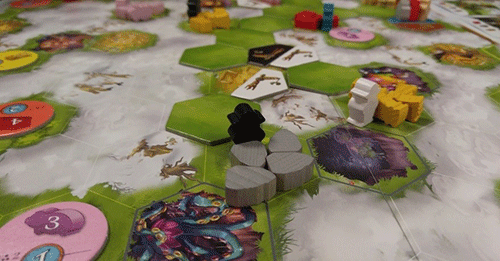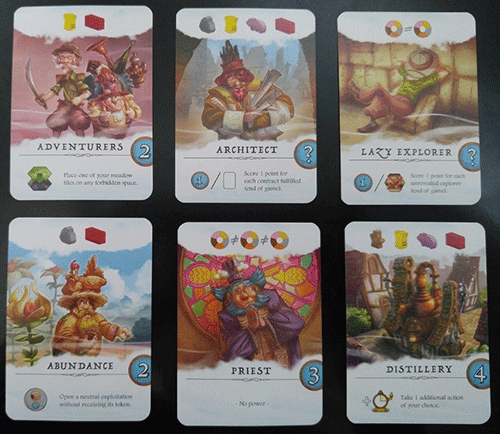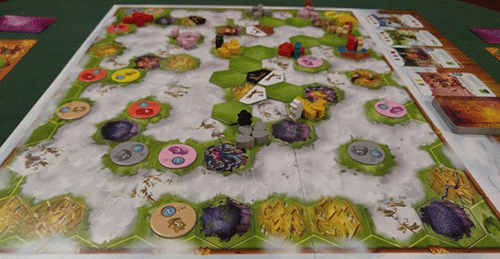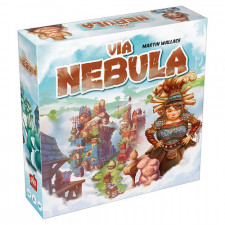Via Nebula Review
on Sep 14, 2016
Martin Wallace is a well-known name in board games. Many games from his long list of designs deal with trains, route building, or just generally laughing at awful I am at managing finances during the industrial revolution. For the most part, his games tend to be more on the thinkier/heavier side, and although I have found them to be interesting, I haven’t necessarily found them to be fun. So it was a bit of an oddity that I even bothered with Via Nebula in the first place.

What am I doing here again?
As a self-professed Euro-snob, I pride myself on declarations that I don’t need pretty components or a well-integrated theme, but once I saw Via Nebula, I couldn’t help but take a few longing glances at its bright, colorful board and fanciful illustrations. The art is reminiscent of the some of the more cutesy-looking Final Fantasy games, like a slightly less anime version of Crystal Chronicles. The people and scenery are so vibrant and, quite frankly, adorable that it is hard to not be pulled in by it. For example, one of the cards has a picture of a man wearing a chicken on his head. No matter how silly it looks, you can’t help but wonder what the story is behind that. Even the resource tokens taunted me with their cartoon-like shapes. (Instinctively, everyone calls the pink tokens “piggies†instead of just “pigsâ€.) And as if the great art and production weren’t enough, even the insert (which favors form over function) is aesthetically pleasing with its token-shaped cutouts. None of this is surprising given Space Cowboys’ track record.

What is the Distillery going to do with that piggy?
Now, there is a backstory to the world depicted in the game and it sounds wonderfully intriguing, but it should be noted that the integration of the setting and narrative are flimsy at best. Ultimately, Via Nebula is just a train game with a fancy up-do and designer gown (or tuxedo and top hat if you prefer your games to be male). Still, even I have to admit that it’s nice to look at such enticing artwork instead of a sepia-toned 19th century industry/railroad-themed board. Enough gawking at the outstanding production and shapely bits.

Hidden in this image: a train game.
Unlike some games where the rules overhead is so onerous that it dissuades you from introducing to others, Via Nebula is the type of game I love to teach because you can be up and running in no time. You have two actions on your turn that you use among five different choices. Mostly, this involves making resources available, building routes, and constructing buildings. The latter is achieved by moving the right resources along routes to complete the building requirements of a card in the row (or your hand). Once you complete a building, you get an immediate bonus, which are things like a precious third action, putting down extra tiles, or even endgame points. Although the winner is whoever has the most points at the end of the game, there is a kind of efficiency race since someone constructing their fifth and final building will force the game into its last round. This is something that may or may not be advantageous to you, depending on where you think you stand compared to others.
Because there are only two actions to do on a turn, Via Nebula is snappy and smooth. However, just because you only have two actions on your turn, this doesn’t mean the decisions are easy. I appreciate how much Via Nebula causes me to tensely debate how I should use my precious two actions when I want to do so much. Since there is no ownership over routes or resources, you must carefully consider where to build connections while simultaneously remembering that everything will ultimately connect anyway. This is reminiscent of the same wonderful conflict of emotions that is present Transamerica; you know that helping yourself helps others and you don’t like it, but everyone ends up having to do so. Patronizing “Thanks!†are aplenty when you open up a resource site or connect a route, saving your opponents an action on their next turn. But don’t worry; your opponents will begrudgingly help you out as well.
This makes the game inherently interactive as you are very much concerned with what others are doing, where they are positioning themselves, whether they are going to snatch up a building card that you’ve been collecting resources for, or plop down their fifth building before you can finish up your own plans. And just as you finish contemplating how to spend your next two actions, it’s already your turn again. Few games seem to succeed at giving you thoughtful choices with limited downtime.

It even looks “kind of†like Age of Steam…doesn’t it?
For some, Via Nebula could be considered a gateway game for route building and pick-up-and-deliver mechanisms. Though, the latter feels less salient than the former. However, this certainly isn’t a complaint. In fact, I have no real complaints about Via Nebula. It isn’t going to wow you with innovation and, because of this, it may end up getting swept under the wave of new releases with shiny gimmicks. However, it’s definitely going to get a ton more plays because it is so easy to bring out during game night, regardless of who I’m playing with. Its simple ruleset, quick playtime, beautiful presentation, and engaging gameplay is something that can be appreciated by many types of gamers, from the hardcore number-crunching train enthusiasts to theme-loving dice-chucking fans.

 Customer Support
Customer Support  Subscribe
Subscribe 




 Account
Account  Wishlist
Wishlist 

